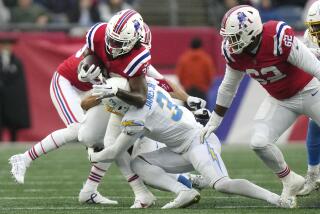The Injury Threat
Longtime writer Bob Oates shares his commentary on the NFL.
- Share via
With Ben Roethlisberger at quarterback and with their new interest in passing, the Pittsburgh Steelers had become the NFL’s team to beat this season in the run for the Super Bowl after his passes had been the principal weapon in a dramatic 24-22 win over San Diego Monday night. Then, with little over a minute remaining in the game, Roethlisberger went down with a gruesome-looking knee injury and Pittsburgh’s season hung in the balance.
When they boarded their Pittsburgh-bound charter early today, the Steelers could look back on Big Ben’s big night in California knowing that with either of their other quarterbacks, Tommy Maddox or Charlie Batch, they would be just another team in the NFL’s parity wing.
Luckily for the Steelers, an MRI on Roethlisberger’s knee was negative — his injuries were diagnosed as a hyperextended left knee and a bone bruise — but the team must have seen its season flash before its eyes. In sports such as baseball, basketball and soccer, an injury play almost never changes the course of the season. In football, though, a crippling series of injuries can happen any time anywhere.
With this season not yet one-third done, late hits and other big hits — legal and illegal — have already taken down two top teams, the New England Patriots and Philadelphia Eagles.
In New England, fans have been asking one another whether the Patriots can win their third straight Super Bowl. But that’s the wrong question. The reality is that last year’s Patriots and this year’s are wholly different teams, made so by the stream of New England wounded in 2005.
Their season was severely crippled when linebacker Tedy Bruschi (concussion) and safety Rodney Harrison (knee) went down with major injuries. There is talk that Bruschi may return this season, but Harrison, who tore his three major knee ligaments, may never play again.
So the real question now is whether the new Patriot team can reach the Super Bowl. Minus Harrison and the other New England starters, this isn’t the same team that had been a big winner.
Nor are the 2005 Eagles the same team that represented the NFC in the Super Bowl last winter. These Eagles have been a different team ever since their quarterback, Donovan McNabb, was hurt by a late hitter five weeks ago, sustaining the internal injuries that have seemed to worsen in every game.
At least McNabb has been able to play. The loss of Roethlisberger would be devastating.
Any team in any sport changes somewhat, of course, from year to year, depending on many variables. But in football, an injury play can drastically change the nature and potential of any pro club, critically impacting its future. That’s the threat that hangs over every title-contending football team on every play.
Eagles Strangely Fail to Rush Bledsoe
IN NFL WEEK 5, pro football’s parity epidemic reached Philadelphia. A surprising performance by Dallas quarterback Drew Bledsoe, combined with another deteriorating performance by Philadelphia quarterback McNabb, evened up the NFC East when the Cowboys won, 33-10.
They won by putting a blocking screen in front of Bledsoe that protected him from the Eagle pass rush. Generations of NFL teams have learned that the only way to beat Bledsoe is to rush him straight up the middle and out of the pocket, which didn’t happen this time for two reasons:
The Cowboys unexpectedly but wisely came out passing when their coach, Bill Parcells, joined — for one game at least — the aggressive passing teams that are steadily taking over the league from running teams.
The Eagles didn’t expect that and didn’t rush Bledsoe as aggressively as Bledsoe threw the ball.
He is as competent as the NFL’s most effective passers when allowed to drop, set and throw. When harassed in the pocket, though, he can be as heavy-legged and incompetent as he often seemed in his Buffalo seasons before the Bills dumped him early this year.
Bledsoe isn’t the only passer who needs launching room, of course, but for years he has been the case example of a passer who falls apart when he doesn’t have that. On a summer day in any training camp, Bledsoe is a picture passer who has entranced every coach and general manager who ever saw him work out. The Philadelphia rush line in the Dallas game had to blur that picture, or fail, and it failed.
Brady’s New Goal: Outscore His Defense
THE DEFENDING-CHAMPION Patriots, in the second month of the long season, will confront the Broncos in Denver Sunday afternoon with a new mission. Quarterback Tom Brady’s new goal in life is — has to be — to outscore his defensive team each week.
The Patriot defense has lost so many starters to injury — including, for one or two games at least, Pro Bowl lineman Richard Seymour — that Brady will have to pile up a lot of points just to offset the yards and points yielded by the rebuilding Patriot defense.
In Week 5, when the Patriot brass agreed to let him out of the shotgun formation, Brady took the first step, outscoring the Atlanta Falcons, 31-28. Usually lining up in conventional old one-back Patriot formations, Brady got off three touchdown passes — including one unbelievably high long one to a sprinting Patriot, Bethel Johnson.
That throw measured at least 65 yards down the field and seemingly half that high into the heavens. In truth, the Atlanta defense gave up on the play, disbelieving that Brady could put the ball out there as far as Johnson seemed to be heading.
During New England’s recent misadventure into shotgun football, running back Corey Dillon was restricted so severely that even his fans kept asking, “What’s the matter with Dillon?” Unleashed again Sunday as Brady, on play after play, lined up under center — with Dillon right behind him — the Patriot ballcarrier had a 106-yard game. His backup, swift-takeoff artist Patrick Pass, averaged more than five yards, netting 34.
The sole difference was and is that in the Patriot offense, a consistent ground game is as improbable in the shotgun as it is probable when the quarterback begins each play under center. And a two-way pass-run threat is essential to winning.
Best of all for Patriot fans, Brady and Dillon both showed in Atlanta what can be accomplished against a good defense when placed in formations that permit a mix of offensive plays. Continuously, the Patriots threatened with Brady when the ball was slipped to Dillon, and threatened with Dillon whenever the team’s real intention was to throw the football. That — by contrast with the shotgun way — is the optimal way to play winning pro football.
A Quarterback Controversy in Atlanta?
THE FALCONS seem bound for a quarterback controversy. Either of their two candidates, veteran Michael Vick or backup Matt Schaub, could outscore New Orleans Sunday, no doubt, but as the long season continues against better opponents, a controversy could and is likely to ripen.
For in Week 5, when Vick was injured, Schaub, in his second year out of Virginia, stepped in and matched Brady point for point until Brady had the last possession, in which the Patriots drove to Adam Vinatieri’s winning field goal in the last 17 seconds.
With Schaub at quarterback, the Falcons looked like a sound football team. When Vick is their quarterback, they usually look like a spectacular sandlot team.
One of the most effective running quarterbacks of all time, Vick isn’t as successful on pass plays. But most football fans, who love to see running quarterbacks, love him anyway.
That will make it difficult for Atlanta to bench Vick for Schaub, though the guess here is that in time, the Falcons — like many other teams with two different but (roughly) equal candidates over the years — will have to turn to the best man to make the playoffs and get through the playoffs. And in Atlanta, based on his performance in this game, that may be Schaub.
Vick, at 6 feet even and listed at 215 pounds, isn’t the most rugged NFL quarterback despite his effective running-play adventuring. Schaub, who stands 6 feet 5 and weighs 237, is a strong, sturdy, straight-throwing passer who in his first NFL start showed a veteran’s coolness. He accumulated 298 passing yards, sixth best in the league that day.
That had an unforeseen result — the best football game of the year so far. On one side, Brady, the finest of active NFL quarterbacks, was playing football again instead of shotgun ball, which hampers him mightily though it took his coaches a long time to see that. On the other side, Schaub was also playing the game properly for coaches who plainly know more football than they have seemed to know when sending Vick out there.
To many sports fans, it will feel like heresy to bench Vick, but if Schaub is the passer he seemed to be on his debut day, his team will doubtless need him to get past Carolina and Tampa Bay in that division.
Bob Oates can be reached at oatesinla@aol.com. Previous columns are available at latimes.com/oates.
More to Read
Go beyond the scoreboard
Get the latest on L.A.'s teams in the daily Sports Report newsletter.
You may occasionally receive promotional content from the Los Angeles Times.










